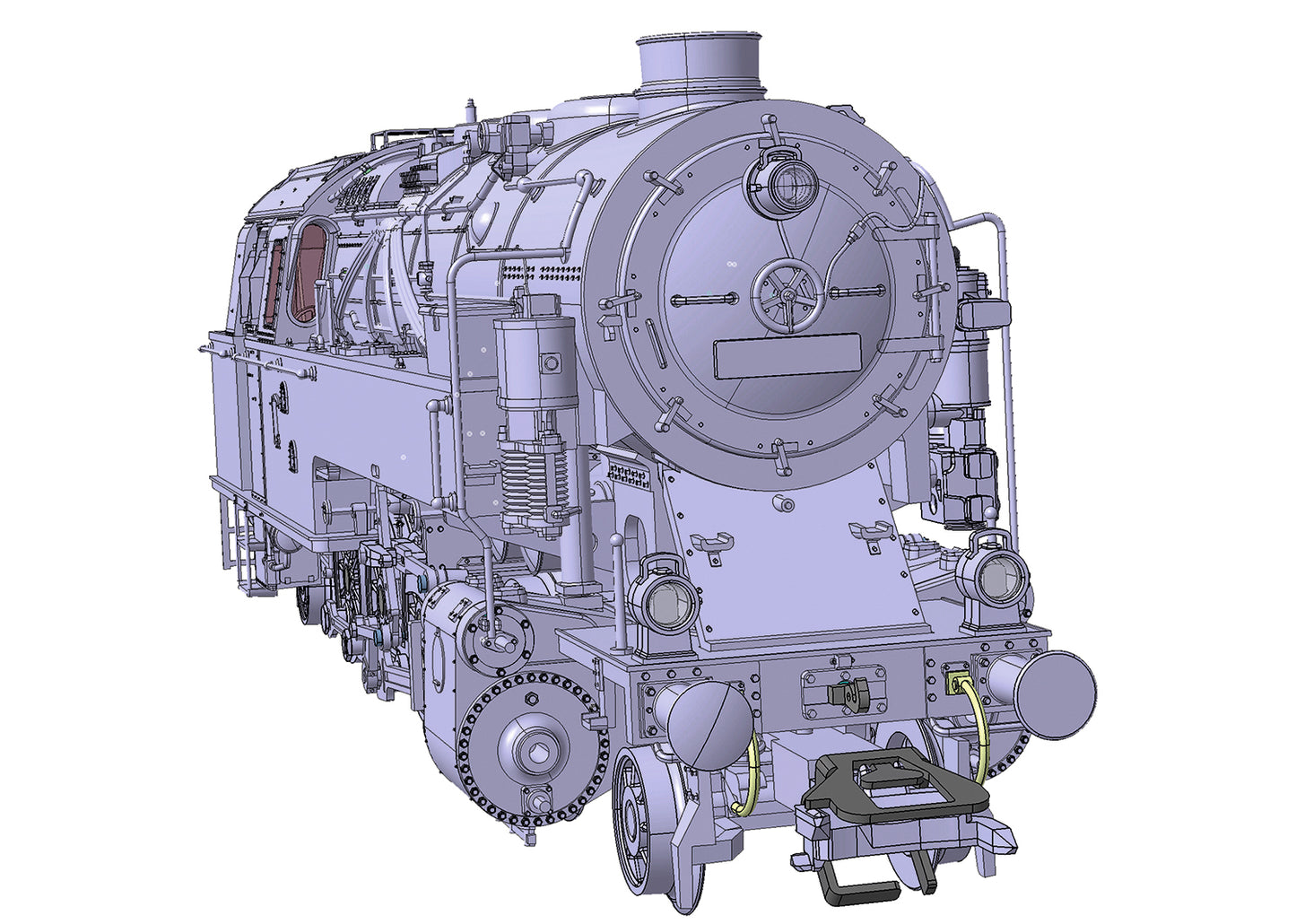Marklin 39097 - Class 95.0 Steam Locomotive with Oil Firing
Model: The locomotive has an mfx+ digital decoder and extensive sound functions. It also has controlled high-efficiency propulsion with a flywheel, mounted in the boiler. 5 axles powered. Traction tires. The locomotive is constructed chiefly of metal. The triple headlights change over with the direction of travel. They and the smoke unit contact will work in conventional operation and can be controlled digitally. In addition, the cab lighting can be controlled digitally. Maintenance-free, warm white LEDs are used for the lighting. There is a close coupler with an NEM pocket and a guide mechanism at both ends of the locomotive.
The minimum radius for operation is 360 mm / 14-3/16". Piston rod protection sleeves and brake hoses are included.
Length over the buffers approximately 17.5 cm / 6-7/8".
Prototype: German State Railroad (DR/GDR) class 95.0 (former Prussian T 20) freight tank locomotive. Version with oil firing. Also included are triple headlights, turbo-dynamo, German State Railroad lanterns, 3 domes, and welded water tanks. Road number 95 0041-4. The locomotive looks as it did around 1978.
Class 95.0 Oil Freight Train Steam Tank LocomotiveAfter successful use of the "Animal Class" tank locomotives (DR 95.66) by the Halberstadt-Blankenburg Railroad (HBE) on its steep route the Rübeland Line, the (Prussian) central railroad office in Berlin also decided on a tank locomotive with five coupled driving axles and contracted with Borsig to design a 2-10-2T tank locomotive with an 18 metric ton axle load. This design was then carried out with only a few changes as the "Prussian T 20". The desired high axle load of 18 metric tons showed that this new locomotive obviously was not intended to replace cogwheel operation with adhesion operation. The roadbed for all Prussian cogwheel lines would have had to be replaced, since they were not authorized for such high axle loads. The plan was more for a powerful unit for motive power and pusher work on steep main lines. The DRG did indeed already exist at the time of the order with Borsig, but the T 20 rightly counts as the last Prussian steam locomotive design with the typical features of the last level of development for Prussian locomotive building: a bar frame and a Belpaire firebox.In 1923/24, Borsig delivered 18 and Hanomag 27 units. The DRG took ownership of all 45 units with the road numbers 95 001-045. They were used chiefly on the steep lines in the Thuringian Forest, the Franconian Forest, the Geislingen Grade, and on the Schiefe Ebene near Neuenmarkt-Wirsberg. After 1945, 14 of these locomotives came to the subsequent DB and 31 locomotives remained on the DR in the GDR. Due to the importance of these units for the DR, there were various improvements in the following years: Between 1957 and 1965, the water tanks and coalbunkers on all of the units were redone in a welded version. Between 1964 and 1973, 24 units had oil firing installed, ten units had new boilers installed, and two were even equipped with new welded cylinders. Starting in July of 1970, the oil-fired locomotives ran as the class 95.00, and the unconverted units and all units with coal firing already in storage were theoretically the class 95.10. By 1980/81, the last oil locomotives were in use at Probstzella. At least five units remained preserved, whereby road number 95 027 of the DB Museum has been available in operational condition again since 2010 for special train use on the Rübeland Line.
Charlie's Tip: A passenger car set to go with this locomotive is being offered under item number 43147.
This model can be found at Ajckids in a DC version in the Trix H0 assortment under item number 25097.
- Partially new tooling.
- Especially finely executed metal construction.
- Partially open bar frame and many separately applied details.
- Cab lighting can also be controlled digitally.
- mfx+ World of Operation decoder and extensive operation and sound functions.
- For still more operating enjoyment in the Märklin "World of Operation".
Oil-Fired in Occasional Border Schedules
First time with oil firing
Many parts redesigned to realize oil firing
Features
Warning
| Control Unit | Mobile Station | Mobile Station 2 | Central Station 1/2 | Central Station 3/2 | |
|---|---|---|---|---|---|
| Headlight(s) | X | X | X | X | X |
| Smoke generator contact | X | X | X | X | X |
| Steam locomotive op. sounds | X | X | X | X | X |
| Locomotive whistle | X | X | X | X | X |
| Direct control | X | X | X | X | X |
| Sound of squealing brakes off | X | X | X | X | |
| Engineer’s cab lighting | X | X | X | X | |
| Bell | X | X | X | X | |
| Letting off Steam | X | X | X | X | |
| Operating Sounds 1 | X | X | X | ||
| Operating Sounds 2 | X | X | X | ||
| Whistle for switching maneuver | X | X | X | ||
| Water Pump | X | X | X | ||
| Injectors | X | X | X | ||
| Switching maneuver | X | X | X | ||
| Air Pump | X | ||||
| Sanding | X | ||||
| Replenishing fuel | X | ||||
| Replenishing fuel | X | ||||
| Replenishing fuel | X | ||||
| Switcher Double "A" Light | X | ||||
| Rail Joints | X | ||||
| Coupler sounds | X |
EAN/UPC: 4001883390970









